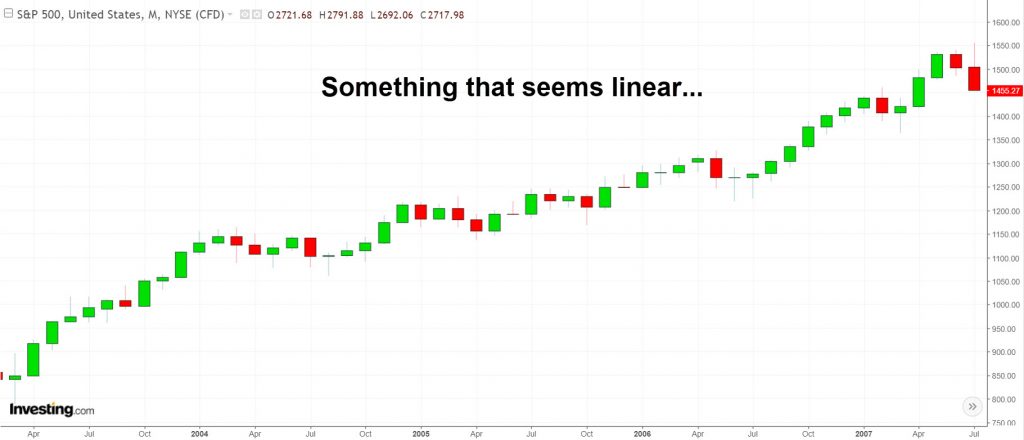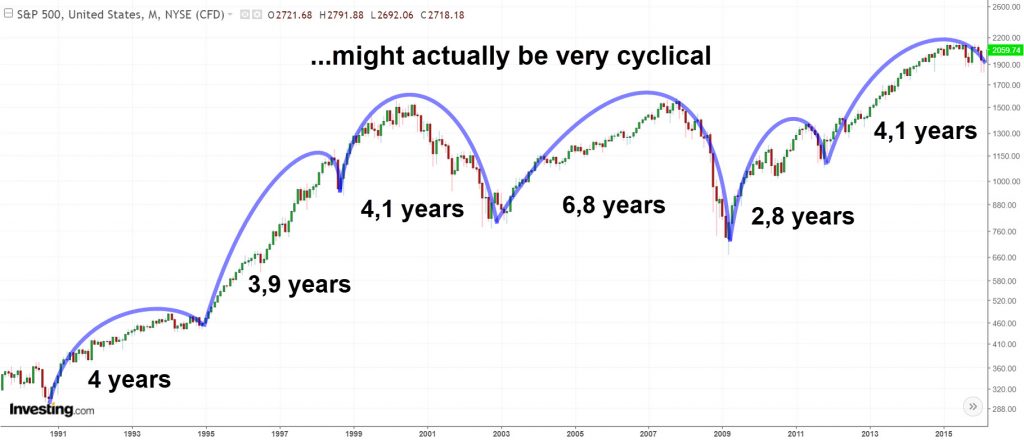Cycles can be found everywhere in nature. Our planet rotates around the Sun, which rotates around the Milky Way, day turns into night, living creature born and die, trees grow leaf’s in spring and drop them in autumn. Even time itself is said to be cyclical by some scientist. I’m not in the reincarnation camp, but I am a cycles believer in rational essence. Most people see things linearly, but the way I see it is that it’s all about perspective. Usually once you scale back far enough, you can see a cycle.
As cycles can be found in nature, it’s logical to think that us humans are destined to operate in cycles. Most of us wake up in the morning and go to sleep in the evening. Our digestion works in cycles. We go to work and we come home again and again. We build houses and tear them down. Traders buy and they sell and they buy and they sell. Even our moods can be mapped so that you can see that we cycle from positive to negative and back.
“History doesn’t repeat itself but it often rhymes”
This quote made famous by Mark Twain is very much true as we can look back to the past and see that politics, wars and epidemics have lots of similarities which can be interpreted as cycles. When a country is born it’s most likely a capitalist society with low taxation and good environment for businesses as it tries to grow and gain influential power amongst other nations. Once the nation has developed sufficiently and is stable enough, the political system starts improving the wellbeing of the nation’s poorest with universal healthcare, public schools and such. The country starts to turn towards socialism. At this point it’s crucial not to overdo the government’s role as that can lead to huge, costly and bureaucratical systems. At some point there usually is a disturbance in the country’s economy which is often blamed on capitalism as was during the 2008 market crash. Yes, capitalism was at the root of the collapse, but so it was the spark in Henry Ford when he came up with the idea of an efficiently working factory. Capitalism is also the root of free markets and many other great inventions. When the disturbance comes, socialism gains even more ground amongst people and eventually can turn into communism. I don’t think it’s necessary to tell where that trail ends. So, you can see that history is full of cycles because they are natural and logical. Once you realize that cycles are everywhere you understand that that is why we have cycles in the markets as well.
Depending on which market you are looking for, cycles are different. To get easily identifiable cycles, it takes broad participation from retail traders to institutional investors. Simply put, in order to have cycles in the market, it requires traders from the smart money camp and the dumb money camp to participate. Smart money is rarely wrong and so we need dumb money to shake the markets from one side to the other with their emotion based buying and selling pressure. In the modern markets, dumb money often acts as a liquidity provider for smart money to enter into position.
We also have different levels of cycles. This is because we have traders operating in different timeframes. We have day traders for the short term, swing traders for the intermediate term and investors for the longer term. When short term traders flip from one side of the boat to the other, we get short term moves such as daily cycle tops and Daily Cycle Lows (DCL). When traders looking at the daily and weekly charts move from bullish to bearish, we get intermediate cycle tops and Intermediate Cycle Lows (ICL). And when the long term investors get desperate and everyone sells as they think it’s the beginning of a new long bear market, we get a multiyear cycle lows which are the biggest cycles in the market.


Above you can see the most influential cycle on the whole market. The 4 year cycle in US stocks. You can also see that not every cycle has exactly the same length. Some cycles are longer than others, but once we get a longer than average cycle, we usually get a shorter than average cycle right after. You can see this from the 2002 – 2007 bull market which was followed by a short cycle that lasted just about 3 years. This is because of the so called rubber band theory, which I’ll dig in deeper in another article. In short, the markets as well as nature tend to have regression to the mean, meaning that abnormalities are offset by opposite abnormalities so that they average out and we end up to the mean. The 4 year cycle has worked extraordinarily well and I highly recommend everyone to take a look at the S&P500 chart and go all the way back to the 30s to see the cycle in effect over the decades.
The cycles happen on all time frames, from days to weeks to months and years. Bigger cycles can be divided into shorter cycles. An intermediate cycle usually consists of 3 daily cycles and so on. This allows us to calculate approximations on when we should expect another cycle low to occur. For example, the next 4 year cycle low in stock will most likely happen in 2020 or 2021. We can use these calculations as a tool amongst others to make educated guesses on whether we should be long or short some particular market. Cycles are one of the main tools that I use in my analyses and I rank them to the top of the tools list alongside with Sentiment.
To receive instant notifications on new posts, follow SKAL Capital on Twitter.
